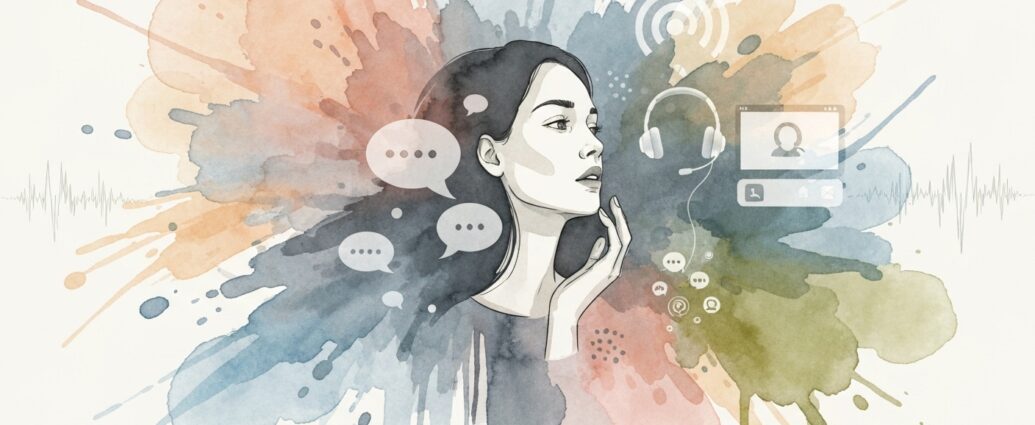I still remember the feeling of trying to schedule my first-ever therapy appointment years ago. I had to call during my lunch break, whisper so my coworkers wouldn’t hear, and then figure out how to take two hours off work to commute to and from an office across town. The whole process felt so stressful, it almost defeated the purpose of seeking help in the first place. Sound familiar? For so many of us, the logistical hurdles have been a major barrier to getting mental health support. That’s where telepsychiatry has completely changed the game. It’s not just a pandemic trend; it’s a fundamental shift in how we access care.
Simply put, telepsychiatry is mental health care, including diagnosis, therapy, and medication management, delivered remotely through technology like video calls. It offers a way to connect with a psychiatrist or therapist from the comfort and privacy of your own home. But is it right for you? In this guide, we’ll walk through the real benefits, the honest challenges, and the practical steps you can take to make online mental health care work for you. You’ll learn how to find a provider, prepare for your session, and ensure your experience is safe, private, and effective.
What Exactly Is Telepsychiatry and How Did It Get So Popular?
While it might feel like a new phenomenon, the concept of telehealth has been around for decades. However, the combination of widespread high-speed internet, ubiquitous smartphones, and the sudden, massive need for remote services during the COVID-19 pandemic created the perfect storm for its explosive growth. Suddenly, what was once a niche option became a lifeline for millions. In fact, a report from the U.S. Department of Health and Human Services showed a staggering 63-fold increase in Medicare telehealth utilization during the pandemic.
Telepsychiatry covers the full spectrum of psychiatric care. This can include:
- Diagnostic evaluations: A psychiatrist can assess your symptoms to diagnose conditions like depression, anxiety, ADHD, or bipolar disorder.
- Psychotherapy (talk therapy): Sessions with a psychiatrist, psychologist, or licensed therapist to develop coping strategies and process experiences.
- Medication management: Prescribing, adjusting, and monitoring the effectiveness and side effects of psychiatric medications.
💡 Pro Tip: Don’t confuse telepsychiatry with general wellness apps. Telepsychiatry involves live sessions with a licensed medical professional, while wellness apps are tools for self-guided meditation, mood tracking, or journaling. Both can be valuable, but they are not the same.
The Real-World Benefits: Why People Are Choosing Virtual Care
The rise of telepsychiatry isn’t just about convenience; it’s about fundamentally improving access to care for people who need it most. Let’s break down the two biggest benefits you’ll experience.
Accessibility: Breaking Down Geographic Barriers
One of the most significant advantages is the breakdown of geographic barriers. According to the Health Resources and Services Administration, over 150 million Americans live in a designated Mental Health Professional Shortage Area. This means that for millions, finding a local psychiatrist is difficult or impossible. Telepsychiatry opens up a statewide, and sometimes national, pool of specialists. If you live in a rural area, have mobility challenges, or need a specialist in a rare condition, virtual care can be the only viable option.
Convenience and Comfort: Care on Your Terms
The convenience factor cannot be overstated. For parents juggling childcare, students with packed class schedules, or professionals with demanding jobs, finding a two-hour block for an in-person appointment is a major challenge. Virtual appointments can be done from your home, your office during a lunch break, or even a parked car, reducing missed work and travel costs. Furthermore, many people find it easier to open up and be vulnerable when they are in a familiar, comfortable environment. Being in your own space can reduce the anxiety and stigma some feel when visiting a psychiatrist’s office.
💡 Pro Tip: Use the time you save on commuting to prepare for and decompress from your session. Spend 15 minutes before your appointment jotting down what you want to discuss, and 15 minutes after to reflect on what you learned.
The Honest Challenges: What to Watch Out For
Of course, telepsychiatry is not a perfect solution for everyone or every situation. It’s important to go in with your eyes open to the potential downsides so you can navigate them effectively.
The “Digital Divide” and Technology Hurdles
The most obvious challenge is the reliance on technology. Not everyone has access to a reliable high-speed internet connection, a private computer, or a smartphone with video capabilities. This is often called the “digital divide.” Even if you have the technology, glitches happen. A frozen screen, poor audio, or a dropped call can be disruptive and frustrating, potentially breaking the flow of an important conversation. It’s crucial to have a backup plan, like a phone number to call your provider if the video fails.
Privacy, Security, and Building a Therapeutic Connection
Privacy is a paramount concern. You must ensure your provider is using a secure, HIPAA-compliant platform for video conferencing, not a standard consumer app like FaceTime or Skype. You also need a private, quiet space for your session where you won’t be overheard. Beyond the technical aspects, some people worry about building a strong therapeutic relationship without being in the same room. A clinician can’t observe subtle body language as easily over video, and some patients may feel less connected through a screen. While many people adapt quickly, it’s a valid concern and something to discuss with your potential provider.
💡 Pro Tip: Before your first session, ask the provider’s office what platform they use and if they have a protocol for technical difficulties. Knowing the plan in advance can reduce anxiety if something goes wrong.
Is Telepsychiatry as Effective as In-Person Treatment? The Evidence Says Yes.
This is the million-dollar question, and the research is overwhelmingly positive. Numerous studies have found that telepsychiatry is just as effective as in-person care for a wide range of mental health conditions, including depression, anxiety, PTSD, and ADHD. A large-scale review published by the World Health Organization concluded that telemental health is effective and can increase access to care.
The key metric for success in therapy is the “therapeutic alliance,” which is the bond of trust and collaboration between you and your clinician. Research has shown that a strong therapeutic alliance can be built just as effectively through video as it can in person. Patient satisfaction rates with telepsychiatry are also consistently high, often because of the added convenience and comfort. For medication management, it has proven to be a safe and effective model for ongoing care.
The bottom line is that the medium of care is less important than the quality of the clinician and your commitment to the process. However, it’s not for every situation. For individuals in an acute crisis, with severe substance use disorders, or with conditions that require close physical monitoring, in-person care may be more appropriate.
A Step-by-Step Plan to Prepare for Your First Telepsychiatry Session
A little preparation can make a huge difference in how comfortable and productive your first session is. Instead of just opening your laptop two minutes before the appointment, try following the SPACE Method: Secure connection, Prepare questions, Allocate time, Create environment, and Eliminate distractions.
- Secure Your Connection (The Day Before): Test your technology. Make sure your internet is stable, your camera and microphone work, and you have downloaded any necessary software. Close unnecessary browser tabs and applications to maximize your bandwidth.
- Prepare Your Questions & Goals (1 Hour Before): Spend 10-15 minutes thinking about what you want to achieve. Why are you seeking help now? What are your main symptoms or challenges? What questions do you have for the psychiatrist? Jotting down a few notes can help you stay on track.
- Allocate Your Time (30 Minutes Before): Block off your calendar for at least 15 minutes before and after the session. Dont schedule a stressful work meeting immediately following your appointment. Give yourself buffer time to get into the right mindset and to process the session afterward.
- Create Your Environment (15 Minutes Before): Find a private, quiet, and well-lit space. Sit in a comfortable chair where your face is clearly visible. If you live with others, let them know you need to be undisturbed for the next hour. Using headphones can enhance privacy and reduce background noise.
- Eliminate Distractions (5 Minutes Before): This is crucial. Put your phone on silent and place it out of reach. Turn off notifications on your computer. You can even use your device’s built-in tools, like Focus Mode, to ensure no alerts pop up. This session is a dedicated time for your wellbeing; protect it.
Outcome Expectations Breakdown
Starting with a new psychiatrist can feel daunting. Here’s a realistic timeline of what to expect:
- First 1-3 Sessions: This is the assessment phase. Your psychiatrist will ask many questions about your history, symptoms, and goals. It’s about getting to know you. You should feel heard and respected, but you may not leave with a full treatment plan just yet.
- First Month: You and your provider should have established initial goals and a treatment plan. If medication is involved, this is the period where you’ll be monitored for effectiveness and side effects. The focus is on stabilization and building the therapeutic alliance.
- 3-6 Months: The real work is happening now. You should be in a steady rhythm with therapy, actively working on coping skills, or have found a stable and effective medication regimen. You should notice some improvement in your symptoms and overall functioning.
- Ongoing Care: For many, mental health care is a long-term journey. Sessions may become less frequent as you feel more stable. The focus shifts to maintenance, relapse prevention, and managing any new challenges that arise.
Effort & Resources Required
- Time commitment: Typically a 45-60 minute session weekly, bi-weekly, or monthly, plus 15-30 minutes of prep and reflection time.
- Costs: Varies widely. Check with your insurance provider. Many plans now cover telepsychiatry the same as in-person visits. Out-of-pocket costs can range from $100 to $400+ per session.
- Skills: Basic tech literacy, self-advocacy to voice your needs and concerns, and a willingness to be open and honest. Learning to set healthy boundaries with your time and space is also key.
- Ongoing maintenance: Consistently attending sessions, doing any “homework” your therapist assigns, and communicating openly about how your treatment is progressing.
Finding the Right Fit: Telepsychiatry vs. In-Person Care
Deciding between virtual and in-person care is a personal choice. Here’s a simple table to help you compare the key factors.
| Factor | Telepsychiatry | In-Person Care | Best For… |
|---|---|---|---|
| Accessibility | Excellent. Overcomes geography, mobility issues, and provider shortages. | Limited by your location and the availability of local clinicians. | Individuals in rural areas or with limited mobility. |
| Convenience | High. No travel time, flexible scheduling, less time off work needed. | Lower. Requires travel, waiting room time, and a larger time block. | People with busy or unpredictable schedules. |
| Technology Need | High. Requires reliable internet, a private device, and tech comfort. | None. Removes all technology as a potential barrier to care. | Those who lack reliable technology or prefer face-to-face interaction. |
| Non-Verbal Cues | Limited. Harder to observe subtle body language through a screen. | Rich. Allows for full observation of body language and presence. | Clinicians or patients who value the nuances of in-person communication. |
Quick Takeaways
- Telepsychiatry is effective, evidence-based mental health care delivered remotely via video, covering therapy, diagnosis, and medication management.
- Its main benefits are dramatically improved accessibility for those in rural or underserved areas and convenience that fits modern life.
- Challenges include the need for reliable technology, ensuring privacy and security, and the potential for feeling less connected through a screen.
- Prepare for your first session using the SPACE Method to ensure it’s a productive and comfortable experience.
- Research shows that for most conditions, telepsychiatry is just as effective as in-person care.
- Always verify that your provider uses a secure, HIPAA-compliant platform to protect your sensitive information.
- The best choice between virtual and in-person care depends on your personal needs, comfort with technology, and the severity of your condition.
- If you are in an immediate crisis, telepsychiatry is not the right tool. Please contact a crisis line or go to the nearest emergency room.
Conclusion: Making Technology Work for Your Mental Health
My “learned the hard way” moment with telepsychiatry was realizing that the quality of my internet connection was directly related to the quality of my session. In one early appointment, my video kept freezing, and I spent more time saying “Can you hear me now?” than actually talking about what mattered. I left feeling frustrated and disconnected. After that, I made a rule: for 45 minutes, my therapy session is the only thing my WiFi is used for. I kick everyone else off the network. It seems small, but protecting that digital space made all the difference.
That’s really the heart of making telepsychiatry work. It’s about being intentional. It’s about taking the incredible access and convenience technology offers and pairing it with the mindful preparation needed to create a sacred space for your mental health. It requires us to become active participants in our care, from setting up our room to advocating for our needs. For those of us who have struggled to access care before, its a revolutionary tool.
If you’ve been on the fence about seeking help, I encourage you to explore telepsychiatry as an option. Start by checking your insurance provider’s directory or looking at reputable online platforms. Remember that finding the right fit is a process, and it’s okay if the first person you talk to isn’t the one. The goal is to find someone you trust. By taking that first step, you’re making a powerful investment in your own wellbeing, proving that no matter where you are, help is within reach.
Frequently Asked Questions About Telepsychiatry
Is telepsychiatry as effective as in-person appointments?
Yes. Extensive research shows that for most common mental health conditions like depression, anxiety, and PTSD, telepsychiatry is just as effective as traditional in-person care. The success of treatment depends more on the quality of the clinician and your relationship with them than the medium used.
How do I know if telepsychiatry is right for me?
Telepsychiatry is a great fit if you value convenience, live in an area with limited local providers, or have mobility challenges. It may be less suitable if you lack reliable internet, don’t have a private space for sessions, or are experiencing a severe crisis that requires in-person intervention.
Can I get medication prescribed through telepsychiatry?
Yes, psychiatrists can prescribe and manage most medications through telepsychiatry. However, regulations for prescribing controlled substances (like stimulants for ADHD or benzodiazepines for anxiety) can vary by state and federal law, and some may require an initial in-person visit. Always check the rules in your location.
What technology do I need for a virtual psychiatry appointment?
You will need a device with a camera and microphone (like a smartphone, tablet, or computer), a reliable high-speed internet connection, and a private, quiet space. Your provider will send you a link to their secure, HIPAA-compliant video platform. You do not need any special expertise to use it.
How long does it take to feel better with telepsychiatry?
This varies greatly for each individual. Some people may start to feel relief after just a few sessions, while for others, it can take a few months to notice significant progress. Consistency is key. Discuss your treatment timeline and goals with your provider to set realistic expectations.



